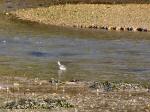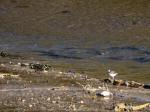| Latin name - Limosa limosa
Black-tailed Godwits can be seen all the year around. There is a small
breeding population in the United Kingdom, whilst others visit in the
spring and autumn on passage to and from their breeding grounds in Northern
Europe to their over-wintering areas in Africa. Birds from Iceland migrate
from their breeding grounds to spend the autumn and winter either in
southern Ireland or here, where they can be seen on coasts and estuaries
mainly in the south and west. Once a common breeding bird in the United
Kingdom it became extinct as a breeding species but has once again started
to breed here. However fewer than 60 pairs of these wading birds breed
in the whole of the UK, most being found at the Ouse Washes near the
border between Cambridgeshire and Norfolk. The black-tailed Godwit is
a fairly large wading bird, with a long straight bill which is a useful
identification aid when trying to distinguish it from the bar-tailed
Godwit with its slightly up-curved bill. Their winter plumage is primarily
grey upper-parts, white under parts and a black tail with broad white
wing bars. However in spring the males develop their summer breeding
plumage
of a bright orange-red breast whilst females, although many develop reddish
patches, are much duller and more like their winter plumage. Young birds
have buff covered heads and breasts. In flight, its long legs protrude
well beyond the tail to counterbalance its long neck and bill, giving
it an elongated appearance.
Black-tailed Godwits breed on wet meadows but are more usually seen
on marshes and muddy estuaries. They feed on insects, worms, snails and
shellfish probing in the mud, often wading in quite deep water. This
photograph was taken at Bowcombe creek, which is part of the Salcombe
and Kingsbridge estuary system, on the 2nd January 2010; unfortunately
from quite a distance at it was difficult to approach closer without
disturbance. |







